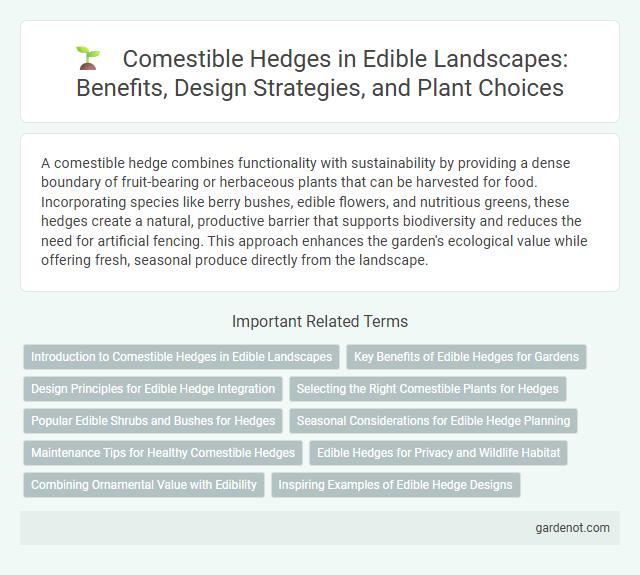A comestible hedge combines functionality with sustainability by providing a dense boundary of fruit-bearing or herbaceous plants that can be harvested for food. Incorporating species like berry bushes, edible flowers, and nutritious greens, these hedges create a natural, productive barrier that supports biodiversity and reduces the need for artificial fencing. This approach enhances the garden's ecological value while offering fresh, seasonal produce directly from the landscape.
Introduction to Comestible Hedges in Edible Landscapes
Comestible hedges in edible landscapes combine functionality and productivity by using shrubs and small trees that provide fruits, nuts, or edible leaves while defining garden boundaries. Popular plants such as hazelnut, serviceberry, and gooseberry offer seasonal harvests, support biodiversity, and contribute to sustainable landscaping. Integrating comestible hedges enhances food security and aesthetic appeal, creating multifunctional green spaces.
Key Benefits of Edible Hedges for Gardens
Edible hedges provide a sustainable source of fresh fruits, nuts, and herbs, enhancing garden productivity while reducing grocery expenses. These plantings support local biodiversity by attracting pollinators and beneficial insects, contributing to a healthier ecosystem. Their natural barrier function improves privacy and wind protection, combining practicality with nutritious harvests in garden design.
Design Principles for Edible Hedge Integration
Effective design principles for integrating comestible hedges involve selecting plant species that provide year-round harvest, such as berry-producing shrubs and nut trees, to maximize yield and aesthetic appeal. Spatial arrangement must balance accessibility for maintenance and harvesting with optimal sun exposure, ensuring healthy growth and fruit production. Incorporating biodiversity through mixed species hedges also promotes pest resistance and soil health, creating a sustainable edible landscape.
Selecting the Right Comestible Plants for Hedges
Selecting the right comestible plants for hedges involves choosing species that provide both aesthetic appeal and productive yields, such as berry-producing shrubs like blueberries, raspberries, and currants. Hardy plants with dense foliage, including hawthorn and gooseberry, create effective living barriers while offering edible fruits. Prioritize native or well-adapted species that thrive in your specific climate and soil conditions to ensure sustainable growth and ease of maintenance.
Popular Edible Shrubs and Bushes for Hedges
Popular edible shrubs and bushes for hedges include blueberries (Vaccinium spp.), which provide attractive foliage and nutritious berries. Other commonly used species are currants (Ribes spp.) and gooseberries (Ribes uva-crispa), both valued for their flavorful fruits and dense growth. These plants not only create natural barriers but also offer a sustainable source of fresh produce in edible landscapes.
Seasonal Considerations for Edible Hedge Planning
Edible hedges require careful seasonal planning to optimize yield and growth, with species selection tailored to local climate zones and frost dates. Incorporating deciduous and evergreen plants ensures year-round interest and food production, balancing early spring blossoms with summer fruiting and fall harvests. Mulching and irrigation schedules aligned with seasonal rainfall patterns enhance soil health and plant resilience throughout the growing cycle.
Maintenance Tips for Healthy Comestible Hedges
Regular pruning stimulates growth and prevents overgrowth in edible hedges, ensuring an abundant yield of fruits or leaves. Mulching around the base conserves soil moisture, reduces weeds, and enriches nutrients vital for healthy plants. Monitoring for pests and diseases early allows timely interventions, maintaining the hedge's productivity and vitality throughout the growing season.
Edible Hedges for Privacy and Wildlife Habitat
Edible hedges combine privacy screening with wildlife habitat by integrating fruit-bearing shrubs and nut trees such as elderberries, hazelnuts, and serviceberries. These living fences provide year-round cover for birds, pollinators, and beneficial insects while offering a sustainable source of food. Strategic planting enhances biodiversity and supports ecosystem resilience in residential or urban gardens.
Combining Ornamental Value with Edibility
Comestible hedges integrate visually appealing plants like lavender, rosemary, and hawthorn that provide seasonal flowers, vibrant foliage, and attractive textures while producing edible fruits, herbs, or leaves. These multifunctional hedges enhance garden aesthetics and support biodiversity by attracting pollinators and beneficial insects. Incorporating edible species into traditional landscaping promotes sustainable food sources and reduces the need for separate kitchen gardening spaces.
Inspiring Examples of Edible Hedge Designs
Edible hedges featuring berry-producing shrubs like blueberries, blackberries, and currants create visually stunning and productive boundaries. Incorporating herbs such as rosemary, lavender, and thyme not only enhances fragrance but attracts pollinators, boosting garden biodiversity. Combining fruit trees with perennial vegetables like asparagus and rhubarb forms a layered, nutrient-rich comestible hedge that maximizes space and sustains year-round harvests.
Comestible hedge Infographic

 gardenot.com
gardenot.com